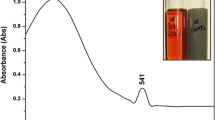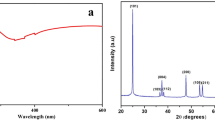Abstract
The biosynthesis of nanomaterial using medicinal plants for biomedical applications is more promising, safe, and cost-effective. The rising resistance to conventional drugs including antibiotics has invoked the need for green synthesized nanoparticles that can be employed as an alternative to these agents. Therefore, in the present study, Artemisia vulgarus extract (ArV) was used as a reducing and capping agent for the preparation of stable titanium oxide nanoparticles (TiONPs) and to evaluate their antimicrobial, anti-fungal and anticancer activity. The aqueous extract of ArV was prepared and used for the preparation of TiONPs by the controlled flow rate of 2 mL/hr by batch method. The obtained nanoparticles were characterized by Scanning Electron Microscopy (SEM), X-ray diffraction (XRD), Energy Dispersion X-rays (EDX), Fourier–transform infrared (FTIR) spectroscopy and ultraviolet–visible (UV-Vis) spectroscopy. FTIR spectroscopy analysis of ArV extract showed the presence of alkaloids and steroids functional groups, which appears like a reducing and capping agent. The UV–visible spectra of ArV extract-prepared TiONPs (ArV-TiONPs) showed absorbance shifts towards the 280 nm region which confirms the synthesis of TiONPs. The ArV-TiONPs were anatase in structure, having a smooth elliptical and spherical shape with an average size of 82 nm ± 12. These nanoparticles have shown significant anti-bacterial activity at a dose of 40 mg/mL against Escherichia coli, however, at a very low dose of 10 mg/mL they have inhibited the growth of Staphylococcus aureus. We have also found an effective anti-fungal activity of these particles against Aspergillus niger at 40 mg/mL, having the highest zone of inhibition (14 mm). In addition, ArV-TiONPs have also significantly (p < 0.0001) induced apoptosis in MCF-7 (breast cancer) cells up to 72% at 80 μg/mL and yielded the 50% inhibitory action (IC50 value) at a concentration of 25.56 ± 1 μg/mL. Our study has proven that ArV extract is a good source of TiONPs synthesis and aids the antibacterial, antifungal and anticancer activity of nanoparticles.











Similar content being viewed by others
Data availability
All data generated or analyzed during this study are included in this published article and are available on request from the corresponding author.
References
Aftab A, Bashir S, Rafique S, Ghani T, Khan R, Bashir M, Ehsan A et al (2020) Microfluidic platform for encapsulation of plant extract in chitosan microcarriers embedding silver nanoparticles for breast cancer cells. Appl Nanosci (switzerland) 10:2281–2293
Ahmad MM, Mushtaq S, Al Qahtani HS, Sedky A, Alam MW (2021) Investigation of TiO2 nanoparticles synthesized by Sol-Gel method for effectual photodegradation. Oxid Reduct React Cryst 11:1456
Alomari AA (2020) Synthesis of silver nanoparticles of aqueous extract of medicinal plant (Artemisia vulgaris L) leaves and its antimicrobial activity. Int J Appl Chem 16:21–34
Anandgaonker P, Kulkarni G, Gaikwad S, Rajbhoj A (2019) Synthesis of TiO2 nanoparticles by electrochemical method and their antibacterial application. Arab J Chem 12:1815–1822
Aravind M, Amalanathan M, Mary MSM (2021) Synthesis of TiO2 nanoparticles by chemical and green synthesis methods and their multifaceted properties. SN Appl Sci 3:1–10
Bhattacharjee R, Kumar L, Mukerjee N, Anand U, Dhasmana A, Preetam S, Bhaumik S et al (2022) The emergence of metal oxide nanoparticles (NPs) as a phytomedicine: a two-facet role in plant growth, nano-toxicity and anti-phyto-microbial activity. Biomedi Pharmacother 155:113658
Das K, Roychoudhury A (2014) Reactive oxygen species (ROS) and response of antioxidants as ROS-scavengers during environmental stress in plants. Front Environ Sci. https://doi.org/10.3389/fenvs.2014.00053
Depciuch J, Kasprzyk I, Roga E, Parlinska-Wojtan M (2016) Analysis of morphological and molecular composition changes in allergenic Artemisia vulgaris L. pollen under traffic pollution using SEM and FTIR spectroscopy. Environ Sci Pollut Res 23:23203–23214
Dicastillo CL de, Correa MG, Martínez FB, Streitt C, Galotto MJ (2020) Antimicrobial Effect of Titanium Dioxide Nanoparticles. Antimicrobial Resistance - A One Health Perspective.
Duarte CA, Goulart LR, de Souza Castro L, de Filice IL, Lima E, Campos-Fernández E, Dantas O, Silva ACA et al (2020) Characterization of crystalline phase of TiO2 nanocrystals, cytotoxicity and cell internalization analysis on human adipose tissue-derived mesenchymal stem cells. Materials 13:4071
Ekiert H, Pajor J, Klin P, Rzepiela A, Ślesak H, Szopa A (2020) Significance of Artemisia Vulgaris L. (Common Mugwort) in the history of medicine and its possible contemporary applications substantiated by phytochemical and pharmacological studies. Molecules (basel, Switzerland) 25:4415
Gonelimali FD, Lin J, Miao W, Xuan J, Charles F, Chen M, Hatab SR (2018) Antimicrobial properties and mechanism of action of some plant extracts against food pathogens and spoilage microorganisms. Front Microbiol 9:1639
Ibrahim H (2020) Nanotechnology and Its Applications to Medicine: an over view. QJM Int J Med. https://doi.org/10.1093/qjmed/hcaa060.008
Iqbal H, Razzaq A, Uzair B, Ul Ain N, Sajjad S, Althobaiti NA, Albalawi AE et al (2021) Breast cancer inhibition by biosynthesized titanium dioxide nanoparticles is comparable to free doxorubicin but appeared safer in BALB/c mice. Materials 14:3155
Irshad MA, Nawaz R, Ur Rehman MZ, Imran M, Ahmad J, Ahmad S, Inam A et al (2020) Synthesis and characterization of titanium dioxide nanoparticles by chemical and green methods and their antifungal activities against wheat rust. Chemosphere 258:127352
Irshad MA, Nawaz R, Ur Rehman MZ, Adrees M, Rizwan M, Ali S, Ahmad S, Tasleem S (2021) Synthesis, characterization and advanced sustainable applications of titanium dioxide nanoparticles: a review. Ecotoxicol Environ Safety 212:111978
Jadidi Kouhbanani MA, Beheshtkhoo N, Amani AM, Taghizadeh S, Beigi V, Zakeri Bazmandeh A, Khalaf N (2018) Green synthesis of iron oxide nanoparticles using Artemisia vulgaris leaf extract and their application as a heterogeneous Fenton-like catalyst for the degradation of methyl orange. Mater Res Express 5:115013
Jafari S, Mahyad B, Hashemzadeh H, Janfaza S, Gholikhani T, Tayebi L (2020) Biomedical applications of TiO2 nanostructures: recent advances. Int J Nanomed 15:3447–3470
Jayaseelan C, Rahuman AA, Roopan SM, Kirthi AV, Venkatesan J, Kim SK, Iyappan M, Siva C (2013) Biological approach to synthesize TiO2 nanoparticles using Aeromonas hydrophila and its antibacterial activity. Spectrochim Acta - Part a: Mol Biomol Spectrosc 107:82–89
Khare T, Oak U, Shriram V, Verma SK, Kumar V (2019) Biologically synthesized nanomaterials and their antimicrobial potentials. Compr Anal Chem 87:263–289
Khashan KS, Sulaiman GM, Abdulameer FA, Albukhaty S, Ibrahem MA, Al-Muhimeed T, Alobaid AA (2021) Antibacterial activity of tio2 nanoparticles prepared by one-step laser ablation in liquid. Appl Sci (switzerland) 11:4623
Kim H, Jeon D, Oh S, Nam KS, Son S, Chan Gye M, Shin I (2019) Titanium dioxide nanoparticles induce apoptosis by interfering with EGFR signaling in human breast cancer cells. Environ Res 175:117–123
Kishore S, Kumar SA, Roy T, Bhardwaj A, Malik S (2022) Nanoemulsion formulations in targeted delivery of cancer Therapeutics. In: Verma S, Verma SK (eds) Advancements in controlled drug delivery systems. IGI Global, Hershey, pp 44–72
Larsson DGJ, Flach CF (2021) Antibiotic resistance in the environment. Nat Rev Microbiol 2021:1–13
Li M, Yin JJ, Wamer WG, Lo YM (2014) Mechanistic characterization of titanium dioxide nanoparticle-induced toxicity using electron spin resonance. J Food Drug Anal 22:76–85
Magaldi S, Mata-Essayag S, Hartung De Capriles C, Perez C, Colella MT, Olaizola C, Ontiveros Y (2004) Well diffusion for antifungal susceptibility testing. Int J Infect Dis 8:39–45
Maheswari P, Ponnusamy S, Harish S, Ganesh MR, Hayakawa Y (2020) Hydrothermal synthesis of pure and bio modified TiO2: Characterization, evaluation of antibacterial activity against gram positive and gram negative bacteria and anticancer activity against KB Oral cancer cell line. Arab J Chem 13:3484–3497
Malik S (2021) Implication of Nanoparticles in Drosophila Toxicology Research. In: Bhat MA, Wani IA, Ashraf S (eds) Applications of nanomaterials in agriculture, food science, and medicine. IGI Global, Hershey, pp 330–340
Murugan K, Dinesh D, Kavithaa K, Paulpandi M, Ponraj T, Alsalhi MS, Devanesan S et al (2016) Hydrothermal synthesis of titanium dioxide nanoparticles: mosquitocidal potential and anticancer activity on human breast cancer cells (MCF-7). Parasitol Res 115:1085–1096
Nicolás-álvarez DE, Andraca-Adame JA, Chanona-Pérez JJ, Méndez-Méndez JV, Borja-Urby R, Cayetano-Castro N, Martínez-Gutiérrez H, López-Salazar P (2021) Effects of TiO2 nanoparticles incorporation into cells of tomato roots. Nanomaterials 11:1127
Nyamukamba P, Okoh O, Mungondori H, Taziwa R, Zinya S (2018) Synthetic methods for titanium dioxide nanoparticles: a review. Titanium dioxide - material for a sustainable environment. In Tech
Pal G, Rai P, Pandey A (2019) Chapter 1 - Green synthesis of nanoparticles: A greener approach for a cleaner future. In: Shukla AK, Iravani S (eds) Green Synthesis, Characterization and Applications of Nanoparticles. Elsevier, pp 1–26
Patil S, Chandrasekaran R (2020) Biogenic nanoparticles: a comprehensive perspective in synthesis, characterization, application and its challenges. J Genetic Eng Biotechnol 18:1–23
Rasheed T, Bilal M, Iqbal HMN, Li C (2017) Green biosynthesis of silver nanoparticles using leaves extract of Artemisia vulgaris and their potential biomedical applications. Colloids Surf, B 158:408–415
Saka A, Shifera Y, Jule LT, Badassa B, Nagaprasad N, Shanmugam R, Priyanka Dwarampudi L et al (2022) Biosynthesis of TiO2 nanoparticles by Caricaceae (Papaya) shell extracts for antifungal application. Sci Rep 12:1–10
Sánchez-López E, Gomes D, Esteruelas G, Bonilla L, Lopez-Machado AL, Galindo R, Cano A et al (2020) Metal-based nanoparticles as antimicrobial agents: an overview. Nanomaterials (basel, Switzerland) 10:292
Sethy NK, Arif Z, Mishra PK, Kumar P (2020) Green synthesis of TiO2 nanoparticles from Syzygium cumini extract for photo-catalytic removal of lead (Pb) in explosive industrial wastewater. Green Proc Synth 9:171–181
Singh N, Pandey R, Chandraker SK, Pandey S, Malik S, Patel D (2022) Use of Wild Edible Plants Can Meet the Needs of Future Generation. Agro-biodiversity and Agri-ecosystem Management. Springer Nature Singapore, Singapore, pp 341–366
Szopa A, Pajor J, Klin P, Rzepiela A, Elansary HO, Al-Mana FA, Mattar MA, Ekiert H (2020) Artemisia absinthium L.—importance in the history of medicine, the latest advances in Phytochemistry and Therapeutical Cosmetological and Culinary uses. Plants 2020(9):1063
Thiruvengadam M, Rajakumar G, Chung I-M (2018) Nanotechnology: current uses and future applications in the food industry. 3 Biotech 8:74
Waghmode MS, Gunjal AB, Mulla JA, Patil NN, Nawani NN (2019) Studies on the titanium dioxide nanoparticles: biosynthesis, applications and remediation. SN Appl Sci 1:1–9
Ye J, Shi J, Zhang M, Zhang Y, Jinqiu Tao S, Jiang YW et al (2021) Novel Alhagi maurorum leaves mediated synthesis of titanium nanoparticles for human breast carcinoma applications: a preclinical trial. Arch Med Sci. https://doi.org/10.5114/aoms/143345
Ziental D, Czarczynska-Goslinska B, Mlynarczyk DT, Glowacka-Sobotta L, Stanisz B, Goslinski T, Sobotta L (2020) Titanium dioxide nanoparticles: prospects and applications in medicine. Nanomaterials 10:387
Acknowledgements
The authors are thankful to Prof. Sadaf Naz and Dr Asima Tayyab from the School of Biological Sciences (SBS), University of the Punjab, Lahore, Punjab, Pakistan, for gifting the MCF-7 cells.
Author information
Authors and Affiliations
Corresponding author
Ethics declarations
Conflict of interest
No conflict of interest was declared.
Additional information
Publisher's Note
Springer Nature remains neutral with regard to jurisdictional claims in published maps and institutional affiliations.
Rights and permissions
Springer Nature or its licensor (e.g. a society or other partner) holds exclusive rights to this article under a publishing agreement with the author(s) or other rightsholder(s); author self-archiving of the accepted manuscript version of this article is solely governed by the terms of such publishing agreement and applicable law.
About this article
Cite this article
Rehman, A.U., Tabassum, A., Aftab, A. et al. Artemisia vulgaris reduced and stabilized titanium oxide nanoparticles for anti-microbial, anti-fungal and anti-cancer activity. Appl Nanosci 13, 6165–6175 (2023). https://doi.org/10.1007/s13204-023-02859-6
Received:
Accepted:
Published:
Issue Date:
DOI: https://doi.org/10.1007/s13204-023-02859-6




